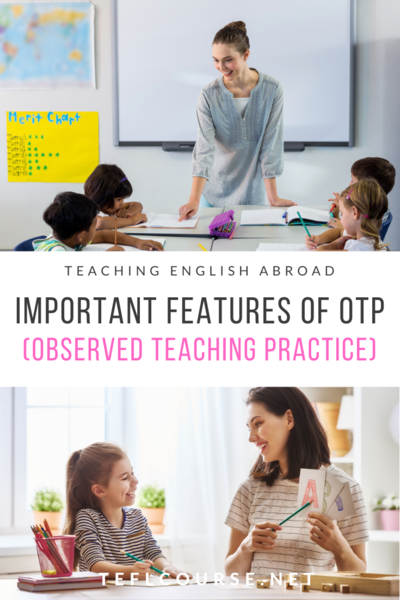The Important Features of OTP

Observation is an essential element in the teaching-learning process. It is a powerful tool that is underestimated by some teachers, the fact which in its turn hinders the progress of the students and slows down the teacher's professional development. Observation can be viewed from different aspects such as peer observation, self-observation, and observation of the students at the lesson.
Table of Contents
Observation of the Students at the lesson
Do you want to teach English abroad? Take a TEFL course!
This post was written by our TEFL certification graduate Alina S. Please note that this blog post might not necessarily represent the beliefs or opinions of ITTT.
Peer Observation
While conducting peer observation two questions may arise. What to observe and how to observe? Peer observation aims to assist your colleague in dealing with different problems that may appear in the teaching practice, be it a young teacher or an experienced one. Peer observation is necessary but it is impossible to conduct a lesson and observe your teaching at the same time as there are so many issues a teacher should have under his/her control: time management, instructions, and instruction checking questions, group division, student involvement, smooth flow of activities, etc.
Before asking to be observed the teachers should choose a problem which he/she would like her peer to pay closer attention to. For instance, it might be a teacher talking time, teacher's instructions and how students react to them or the involvement of some students in the lesson. There are certain rules for the person who comes to the classroom to observe. It's better to choose a place at the back of the classroom so as not to intrude into the lesson procedure. The observer should neither make comments on the lesson procedure during the lesson nor correct or compliment students on their performance. It's better to make notes while observing in order not to forget some points for discussion later on. It is important to remember that when you give your feedback after the observation you should start with some positive moments you have witnessed at the lesson before criticizing something. If you have some ideas for improvement they should be suggested in such a way so as not to produce a counter effect.

Also Read: Is Tutoring Better Than Teaching a Group?
There are a lot of observation sheets on the internet. They are easy to find or observers can come up with their ideas about what to include in their observation sheets. Apart from factual information such as the name of the teacher, the date, the name of the class, the gender of the students and their level, observation sheet may include such points as objectives of the lesson and how they are achieved, type of interaction, student involvement, teacher's feedback, managing and maintaining discipline, rapport, if there was a warm-up, how new material was presented and practiced, TTT, ICQs, and CCQs, etc.
Self Observation
Self-observation or reflection is a powerful tool of any teacher who intends to grow professionally. Different challenges may constantly arise and it is better to be prepared for them than to deal with them in a rush. The main idea of self-observation is to analyze your teaching methods, think about the latest challenges you faced or think of anticipated problems at the future lesson and conduct an Action Research to identify points for improvement and come up with a plan on how to eliminate them in your further teaching practice. Action Research acts as a plan on collecting and analyzing data, identifying areas of difficulties and deciding on the way to deal with them. Action Research has several stages. First, a teacher starts with the identification of a problem or a challenge that deteriorates his/her teaching.
Also Read: Do I need a degree to teach English abroad?
The second stage is data collecting on when this problem or challenge appeared, how it affected the teacher and students and what consequences it resulted in. The third stage is thinking of a plan or a solution to deal with the identified problem. A teacher may need to tend to some online resources and investigate the problem through extensive reading or ask senior teachers for assistance and advice to work out a solution or a plan to deal with the existing problem. It is also necessary to think about how to collect evidence that your action plan was implemented successfully and had a positive influence on the participants of the teaching-learning process.
The quickest form of self-observation is the reflection on your lesson plan after the lesson has been conducted. Teachers may ask themselves three questions like what went well, what didn't go well, and what can be improved in the future? These simple stems may lead to a significant improvement in teaching.

Observation of the Students at the lesson
Observation of the students deals with formative assessment and works well with students of all ages especially the young learners. The main aim of formative assessment is to assist and support students in their efforts to mastering a foreign language. We should view students as individuals with their strengths and weaknesses who have their own pace in language learning. That is why it is advisable not to compare students with each other but observe and note the individual progress of every student concerning efforts he/she applied and his/her previous achievement. Moreover, some activate at the lesson cannot be formally assessed. Such factors as leadership, involvement in the lesson procedure, readiness to help the peers, individual contribution in group and pair work is impossible to assess by giving marks.
Also Read: How much does a TEFL course cost?
On the other hand, they are far from being insignificant in students' learning. The only way out is a formative assessment. The student should know that their efforts have been noticed and appreciated. The instruments of formative assessment may be praise, some simple rewards as the nomination for the role of teacher's assistant in handing out worksheets, sitting at a teacher's desk for younger students or the possibility to choose a team for group work or projects among senior students. It is also a good idea for the teacher to work out an individual student observation worksheet.It is possible to include academic and non-academic achievement like the leadership of an individual student. The teacher can't observe all the students at all lessons. That is why teachers should decide for themselves what student or group of students or which skills or achievements to choose to observe at a particular lesson.
Do you want to teach English abroad? Take a TEFL course!
In conclusion, observation should be viewed as an essential and inseparable element of teaching practice. The sooner teachers accept and implement it the better results they will achieve in their steps to success.
Apply now & get certified to teach english abroad!
Speak with an ITTT advisor today to put together your personal plan for teaching English abroad.
Send us an email or call us toll-free at 1-800-490-0531 to speak with an ITTT advisor today.
Related Articles:
- What It's Like Being a Bilingual Kindergarten Teacher in China
- English as a Matter of Global Citizenship
- Rules of Phonetics and Phonology in ESL Teaching
- Challenges of Teaching a Monolingual Class in Italy
- What is an Effective Lesson Planning Strategy?




